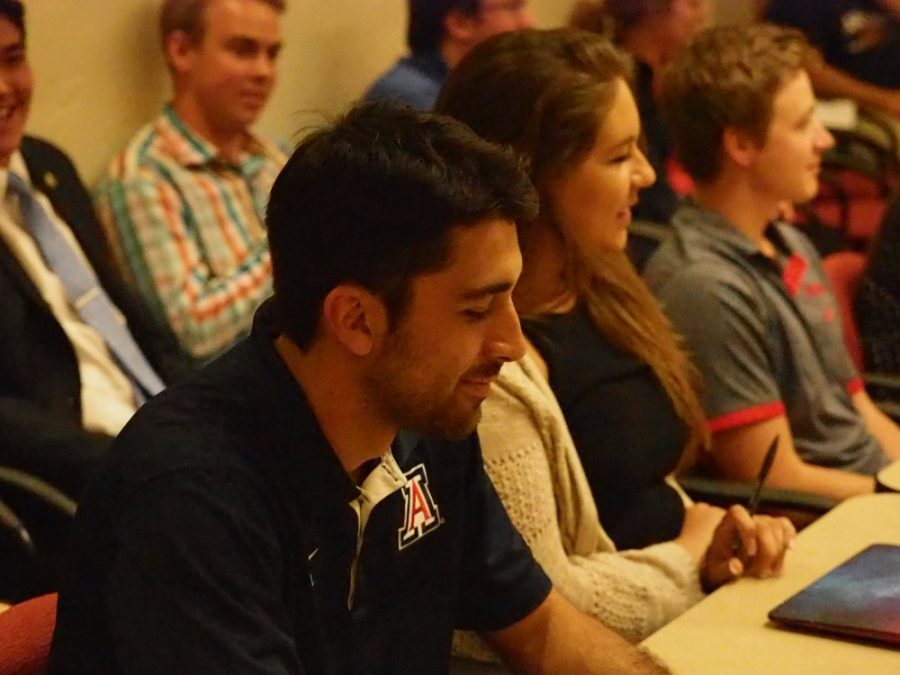ASUA Senate moves toward comprehensive representation
Logan Cook
ASUA senators discussed various amendments and bylaws during their meeting on Wednesday, April 5.
April 6, 2017
The population of the Associated Students of the University of Arizona Senate is beginning to see some variety since the change in senate structure two years ago, but some say it still has a long way to go to fully represent the academically diverse UA student body.
Before the change in structure, there were only 10 at-large ASUA senators representing the UA student body as a whole.
Now, senate population is capped at 20 senators.
“In the perfect world there would be 17 senators from each college and then three at-large senators,” said Trey Cox, executive vice president of ASUA.
This restructure was designed to serve more students.
As opposed to at-large senators, college-specific senators are meant to solely represent the students within their college. These candidates may only be voted on by students in their college.
However, in the most recent election cycle, the college-specific candidates were only competing for 11 out of the 17 college-specific senate positions.
The most competitive college was the College of Humanities, with four candidates running for one position. The others had three candidates or fewer running for one position.
Furthermore, six of the college-specific candidates ran unopposed, taking their positions by default.
Cox attributed this to the fact that the current senate structure is in its infancy; there were six colleges left unrepresented in the most recent election.
These college-specific vacancies turn into spots for candidates running for an at-large position.
RELATED: ASUA election codes cause confusion among candidates during latest election
There were 11 candidates running for the three at-large positions. With the additional six vacant college-specific positions taken into account, it means all but two of the at-large candidates now have a spot in ASUA Senate.
This leaves ASUA Senate with 11 college-specific senators and nine at-large senators rather than the ideal 17 college-specific senators and three at-large senators.
According to Cox, since the structure is new, the senate has not yet had an election where people apply for every college-specific spot.
He attributes this to a lack of communication between ASUA and the colleges that had positions left vacant or taken with little to no competition.
“It’s definitely a problem with marketing,” Cox said. “We need to communicate with certain colleges more than we do.”
Six unopposed candidates may seem high, but college-specific representation in ASUA has improved greatly, according to Michael Finnegan, ASUA president.
“The first year we implemented the change to senate structure, there were only six college representatives,” he said. “We’re reaching out more than ever before and it’s going to take some time to get every college represented in ASUA Senate.”
Aside from academic diversity, ASUA Senators come from an array of organizations on campus, according to current ASUA Senator and President-elect Matt Lubisich.
“The colleges with a lot of undergraduate students tend to have more competition during senate elections,” he said.
He said ASUA senate populations frequently have candidates who were involved in Freshman Class Council, a group of 50 freshmen who get involved in UA outreach opportunities while simultaneously getting a glimpse into the structure of ASUA.
Having been in the organization at one point himself, Lubisich said the only similarity between FCC and being an ASUA senator is that its members get acclimated to the ASUA office.
“In FCC you’re able to shadow senate, but that only gives you an idea of how senate works,” he added. “Once you actually become a senator and get thrown into the fire it’s much different.”
Cox clarified that even though there is usually a number of FCC-affiliated ASUA senators, there is no parallel between the positions.
“Everything you do as a senator is like nothing you would do in FCC,” he explained. “They only introduce the idea of senate.”
In the past, senators have tended to be from FCC, Greek Life and Residence Life, according to Lubisich.
RELATED: Lubisich rises through ranks to ASUA presidency
Colleges that are currently not represented in ASUA senate include: The James E. Rogers College of Law, the Graduate College, the College of Pharmacy, the College of Optical Sciences, the College of Nursing and the College of Architecture, Planning and Landscape Architecture.
According to enrollment numbers on the UA Colleges site, this leaves hundreds of UA students without college-specific representation in ASUA senate.
Julia Ni, a junior in the College of Nursing, expressed her concern about the lack of academic representation in ASUA Senate.
“Nursing students have to pay extra fees, so I think the college definitely warrants representation in ASUA Senate,” she said. “I understand having to put an at-large senator in the vacant positions, but I would prefer to have someone from my college representing me.”
Cox predicts with certainty that every college will be represented within three to four years.
“The issue now is that college-specific senators are so new they don’t have a clearly defined role,” he said. “When the new system gets solidified, it will do well to diversify in terms of representing every college.”
Follow Jessica Blackburn on Twitter.




